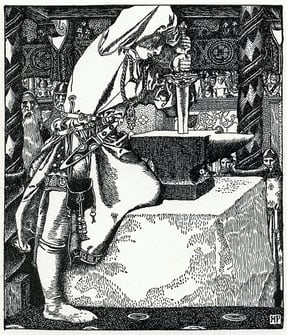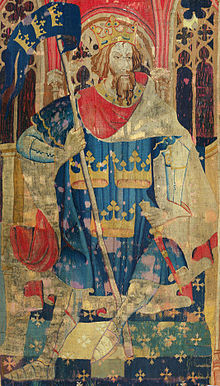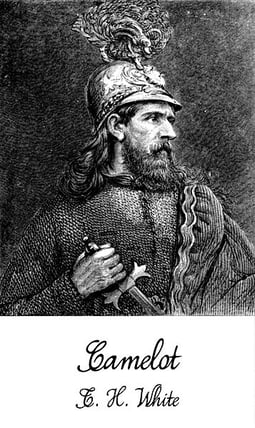T.H. White is the man best known for writing the King Arthur books; the ones about the young boy who pulls a sword from a stone and creates Camelot with his wizard mentor Merlin. These stories are beloved, retold, and have been reinvented as animated films and full scale musicals, even defining the time in America before the assassination of President Kennedy.
Camelot, it seems, is a perfect place, one where there is no trouble, life is easy, and love is pure. White’s life, however, bore no resemblance to such a place, and his battle with alcohol, emotion, and his own natural tendencies influenced his work and led him to live a truly lonely yet remarkable life.
 His life began, and was formed, in tragic trauma at the hands of his headmasters and classmates. Bullied, beaten, and alone, White barely survived his youth with his sanity in tact. He also realized when he came of age that he was a sexual sadist and a homosexual. He recognized his own nature as complete, absolute, and unchangeable. His reclusion into himself and the creation of his own world came from both feeling abused by and unhappy with humanity, as well as paradoxically wanting to prevent himself from inflicting pain on others.
His life began, and was formed, in tragic trauma at the hands of his headmasters and classmates. Bullied, beaten, and alone, White barely survived his youth with his sanity in tact. He also realized when he came of age that he was a sexual sadist and a homosexual. He recognized his own nature as complete, absolute, and unchangeable. His reclusion into himself and the creation of his own world came from both feeling abused by and unhappy with humanity, as well as paradoxically wanting to prevent himself from inflicting pain on others.
White, having decided that human beings were the wrong sort of creatures with which to align himself, turned instead to animals. He became fixated on the idea of training a goshawk, a bird of prey notoriously difficult to command and bond with. He tried, but made fatal mistakes. Trying to gain the bird’s love, White overfed it causing its weight to increase and destroying the potential relationship based on food and training. The bird then had no interest in hunting (being well fed) and no interest in White, as they had not completed the training necessary. Eventually the bird, named “Gos” by White, flew away, and White went on to write The Goshawk about his experiences.
 Around this same time, inspired by Thomas Malory's Le Morte D'Arthur, he began writing the King Arthur legends, describing a small boy who had been orphaned, neglected, and bullied and finds himself helpless in a cold world. Unlike White, young Arthur is taken in and loved by Merlin, and taught the ways of the world. He is saved by both mentorship and the ability to turn into a variety of different animals. White, rotten with the most vivid feelings a man could have, desired only to have this experience: to be loved, to be protected, and to escape his human form and become one with the animals.
Around this same time, inspired by Thomas Malory's Le Morte D'Arthur, he began writing the King Arthur legends, describing a small boy who had been orphaned, neglected, and bullied and finds himself helpless in a cold world. Unlike White, young Arthur is taken in and loved by Merlin, and taught the ways of the world. He is saved by both mentorship and the ability to turn into a variety of different animals. White, rotten with the most vivid feelings a man could have, desired only to have this experience: to be loved, to be protected, and to escape his human form and become one with the animals.
White never married, had no relationships, and poured all of his available love, which was considerable, into his canine companion, an Irish Setter named “Brownie.” After Brownie met a sudden, and unexpected end, the writer sent grief stricken messages to his friend David Bunny Garnett: “I had made her live through me, as I lived through her. Brownie was my life and I am lonely for just such another reservoir for my love.” And so he was, overflowing with love, affection, and need, and unable to find a way to express or deliver his feelings outside of his work.
Alas, the world he created was not the one he lived in. He once wrote: "Everything collapsed at a critical time in my life and ever since I have been arming myself against disaster," and so it was.
Having been born to unhappy people who disliked each other, he was deposited at his grandparents’ house and left there. Just as things were looking up, his life full of love and protection, he was sent off to school where he suffered incredibly. This trauma shaped his response to the world, to himself, and created a need to express a possible world where things would be better and magic could save and protect.
His books about knighthood, royalty, and the magic behind true valor and honor totaled four, The Sword in the Stone, The Queen of Air and Darkness (also known as The Witch in the Wood), The Ill-Made Knight, and The Candle in the Wind. The compilation of the four volumes was titled The Once and Future King, but there was a fifth book.
 The Book of Merlin, which would go on to spend 24 weeks on the New York Times best-seller list, was only discovered in 1977. Until then The Candle in the Wind was thought to be the final book in the King Arthur Series. The reasons for the delay were not that he had kept the volume secret, but in reality that the book specified pacifism, which during WWII was an unpopular stance to take. There was also a paper shortage, so the publishing of potentially unpopular and unpatriotic works were at the bottom of the priority list for most publishers. More than simply passive, the book expresses anger at the lack of humanity or compassion in the world and reveals a very lonely misanthrope at the heart of the King Arthur stories.
The Book of Merlin, which would go on to spend 24 weeks on the New York Times best-seller list, was only discovered in 1977. Until then The Candle in the Wind was thought to be the final book in the King Arthur Series. The reasons for the delay were not that he had kept the volume secret, but in reality that the book specified pacifism, which during WWII was an unpopular stance to take. There was also a paper shortage, so the publishing of potentially unpopular and unpatriotic works were at the bottom of the priority list for most publishers. More than simply passive, the book expresses anger at the lack of humanity or compassion in the world and reveals a very lonely misanthrope at the heart of the King Arthur stories.
White died as he had lived: active and alone. He was on a lecture tour and was found dead in his cabin aboard a cruise ship in the Mediterranean in 1964. Barely known, never truly loved, and having spent his life trying to reinvent and rewrite his formative years and his own nature, White lived a fascinating and mysterious life.
If boys can pull swords from stones, if old men can teach without punishment, if utopia can exist in a sea of betrayal and violence, then perhaps the world isn’t such an empty place after all.

-The Once and Future King. (n.d.). Retrieved May 01, 2016, here.
-T.H. White. (n.d.). Retrieved May 01, 2016, here.
-Bodio, S., & Jameson, C. M. (n.d.). Remembering T. H. White [Web log post]. Retrieved April 30, 2016, here.
-The story of Arthur drawing the sword from a stone appeared in Robert de Boron's 13th-century Merlin. [Photograph]. (1903).
-Macdonald, H. (2015). H is for Hawk. Grove Press.








